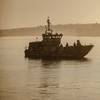COMSAT Mobile Communications' (CMC) Santa Paula, California, earth station is celebrating 25 years of continuous, around-the-clock operations, providing the critical communications link for customers on land, at sea, and in the air. CMC's west coast facility provides Inmarsat satellite communications coverage from western North America, across the Pacific Ocean and into Asia, the Pacific Rim nations, New Zealand, Australia, and the eastern Indian Ocean.
The Santa Paula station has served as a principal communications lifeline providing instant communications to ships at sea, aircraft, and to people located in parts of the world where there is no communications infrastructure. For a quarter century, Santa Paula has often provided their sole means of contact with the rest of the world. The facility supports a wide range of global voice and data solutions, enabling customers to make calls, transfer data, access the Internet, conduct e-commerce, and send faxes and e-mails from virtually anywhere in the world to support the needs of global industries.
Today, the Santa Paula earth station provides continuous satellite voice and data connectivity for the United States Armed Forces as well as a myriad of industries that require high-quality mobile communications, including shipping, energy exploration and scientific expeditions, international and domestic commercial and freight airlines, cruise lines, and the news media.
The facility also provides a central link for the Federal Aviation Administration's Wide Area Augmentation System (WAAS), a space-based commercial aircraft navigation system that enhances air traffic control and aviation safety.
Santa Paula technicians also oversee the satellite connections that provide mobile communications services to various cruise lines and pleasure ships.
"COMSAT Mobile Communications feels a tremendous sense of pride for the 25 years of ongoing commercial service provided by our Santa Paula earth station," said Kathryn Y. Holman, vice president and general manager of COMSAT Mobile Communications. "This earth station and its communications systems are extremely complex and our team of highly skilled employees at Santa Paula are integral to our mission success. " Since beginning commercial mobile satellite communications in 1976, Santa Paula has remained at the leading edge of technology, constantly updating equipment and adding new services and features to meet the evolving communications needs of its business customers. Earlier this year technicians installed a new fully digitized voice and data system permitting faster call setup, saving callers time and money and a new "Direct Internet Access" feature. This Fall, CMC plans to launch its new mobile packet data service, a global Internet Protocol (IP) service designed for such applications as Web access, file transfer, and e-mail using Inmarsat's Global Area Network technology.
Santa Paula ushered in the era of commercial mobile satellite communications for the Pacific Ocean region on August 15, 1976, when the first Telex call was made from the cargo ship Mercury operating in the Pacific Ocean to an office in Bermuda. Mobile satellite communications for business had begun and the technology has continued to evolve to meet the full array of communications needs of today's commercial customers.
The facility has continued to revolutionize global business communications, supporting global and domestic industries that rely on real-time voice and data communications time and money. According to Greg Myers, the technical manager of the Lamont-Doherty Earth Observatory's Borehole Research Group, "Shipboard scientists now realize the benefits of using mobile high-speed data communications, including electronic file transfer and Internet access, with excellent throughput rates to our remote location. Information transmitted from ship-to-shore for processing is now received, analyzed, and routinely turned back to the ship in a few days -- instead of the weeks it used to take. This method of transfer has significantly reduced the extent of the post-cruise data reprocessing and has greatly accelerated processed information delivery to the participating scientific community."
In June of 1998, the USS Missouri, America's enduring symbol of the end of World War II, was towed from Bremerton, Washington, to its final "home" in Pearl Harbor, Hawaii. Covering the final voyage, journalist Bob Wernet dispatched daily media reports and photos through the Santa Paula earth station to an international audience of media and websites. He also communicated daily via e-mail with schools and students around the world.
"COMSAT Mobile's Santa Paula facility provided the critical communications link for my daily reports," Wernet said. "While at sea, the mobile satellite communications were used to keep the crew in touch with the rest of the world. During the month-long voyage, we transmitted large volumes of e-mails, logistical reports, daily news dispatches, as well as responding to a myriad of requests from the media for information."
The U.S. Armed Forces remain an important customer for communications services transiting Santa Paula. The facility has been the conduit for morale, welfare and recreational broadcasts to sailors and Marines aboard ships throughout the Pacific and soldiers and airmen stationed overseas in remote locations including the Japan, Korea, and Okinawa. The facility also serves as a communications link for service members stationed shipboard in the Pacific to call home. The Santa Paula facility has helped keep the President of the United States in touch with the world while traveling aboard Air Force One. Air Force One is equipped with Inmarsat aeronautical satellite systems that provide passengers and crew with voice, fax, and data communications. It is quite common for Air Force One to have all communications channels in use. In addition to official state communications, the Inmarsat system provides the media representatives traveling with the president the ability to file immediate news dispatches to editors and news outlets internationally.
It also can link journalists assigned to the Department of Defense Media Pool with their editors and network studios back in the U.S. CMC's Santa Paula facility has handled just about every type of event and incident imaginable. After the 1989 Exxon Valdez oil spill off the coast of Alaska, the Santa Paula operators and technicians played a critical role in the clean up efforts by setting up a special 24-hour communications link among ships involved in cleanup operations. A framed commendation from Exxon to the staff of the Santa Paula earth station for their contributions to the cleanup efforts remains proudly displayed today. Since 1998, the Santa Paula facility has served as a global focal point for the United States Coast Guard's Automated Mutual-assistance Vessel Rescue program (AMVER) and the National Oceanic and Atmospheric Administration's Shipboard Environmental Data Acquisition Systems (SEAS) Program. Hundred's of commercial vessels participate in these programs in which ships report departure and destination information along with onboard search and rescue capabilities and periodic weather conditions. The Coast Guard and NOAA offer this satellite messaging service free through CMC to participating ships. The Santa Paula facility processes AMVER requests for assistance weekly and has been the "lifeline" to hundreds of mariners at sea. The Coast Guard is recognizing the maritime safety contributions of COMSAT Mobile and its Santa Paula earth station with a special AMVER Appreciation Maritime Safety Award.
"As the facility begins its second 25 years, technicians will continue to deploy the most advanced mobile satellite communications technology at the Santa Paula facility and our staff of professional technicians and engineers will continue to offer an around-the-clock communications lifeline for mobile customers on land, at sea, and in the air," Holman said.
Featured videos

Inside the Electrified Truckable Tug

Tracking Foreign Vessels Working in the U.S. Jones Act Market

Inmarsat Enhances Service to Drive Digitalization
Subscribe for
Maritime Reporter E-News
Maritime Reporter E-News is the maritime industry's largest circulation and most authoritative ENews Service, delivered to your Email five times per week









